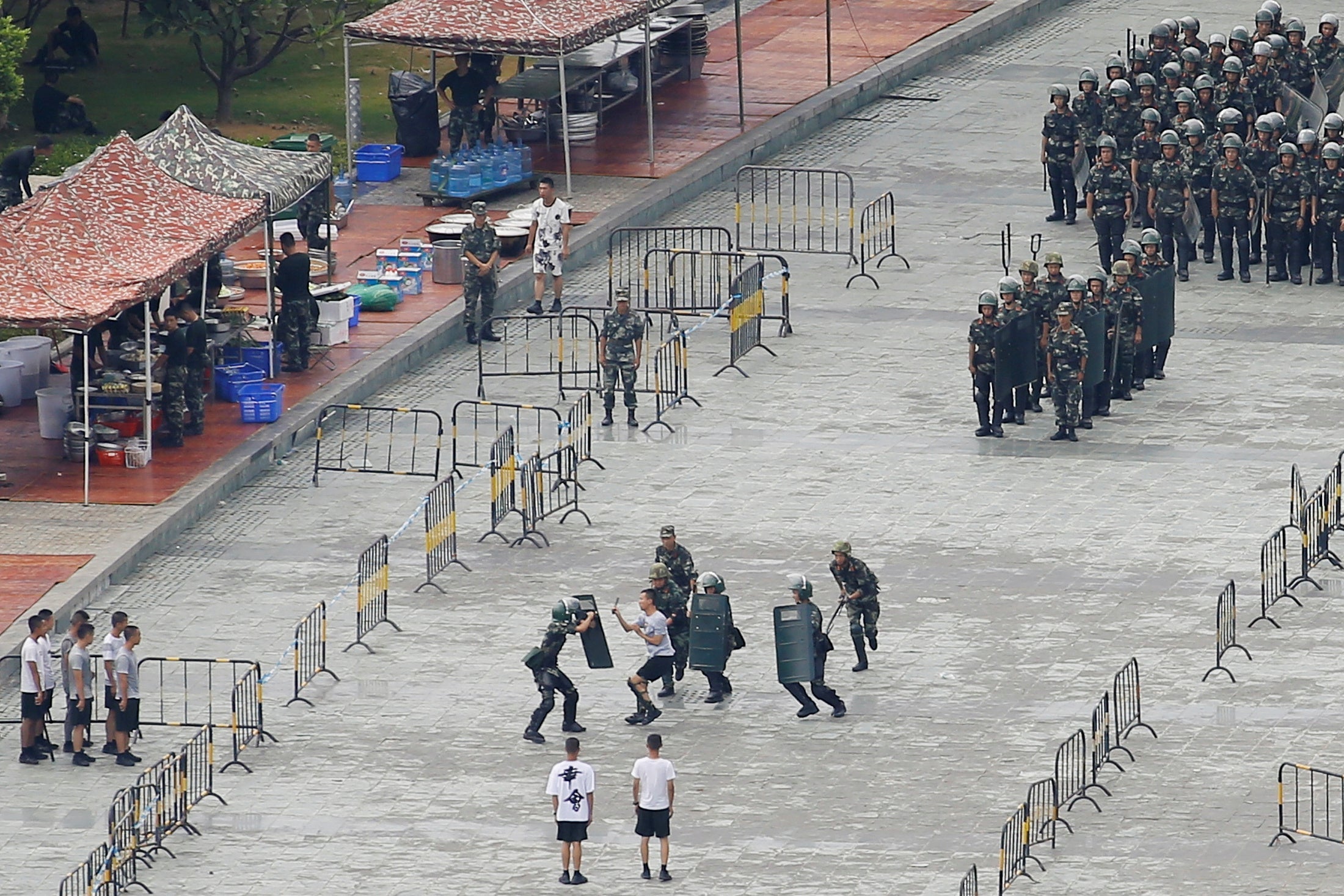Chinese state media says Hong Kong intervention ‘at Beijing’s disposal’ but won’t be repeat of Tiananmen
Near border with Hong Kong, police could be seen conducting second day of drills in military fatigues, using shields, poles and other riot-control gear

Your support helps us to tell the story
From reproductive rights to climate change to Big Tech, The Independent is on the ground when the story is developing. Whether it's investigating the financials of Elon Musk's pro-Trump PAC or producing our latest documentary, 'The A Word', which shines a light on the American women fighting for reproductive rights, we know how important it is to parse out the facts from the messaging.
At such a critical moment in US history, we need reporters on the ground. Your donation allows us to keep sending journalists to speak to both sides of the story.
The Independent is trusted by Americans across the entire political spectrum. And unlike many other quality news outlets, we choose not to lock Americans out of our reporting and analysis with paywalls. We believe quality journalism should be available to everyone, paid for by those who can afford it.
Your support makes all the difference.China’s state media has said that a military intervention in Hong Kong is “at Beijing’s disposal”, but rejected the suggestion that it would mean a repeat of scenes from the 1989 Tiananmen Square massacre.
An editorial for the Communist Party-run Global Times tabloid confirmed that paramilitary training exercises being staged near the border with Hong Kong should be seen as a “clear warning” to protesters, whom the newspaper dubbed “rioters”.
On Friday, Chinese forces were seen marching and taking part in crowd-control drills using riot shields, manoeuvring between barricades set up on the sports field at an arena in Shenzhen, some 30km (19 miles) from Hong Kong city centre.
It was the second day of drills that began on Thursday and led the US national security adviser John Bolton to warn China that “it would be a big mistake to create a new memory like [Tiananmen Square] in Hong Kong”.
Mr Bolton told VOA News that “people in America remember” the massacre on 4 June 1989 when Chinese soldiers opened fire on student protesters in Beijing, with estimated death tolls ranging from several hundred to “at least 10,000”.
In Shenzhen, police could be seen from a distance conducting drills in military fatigues, using shields, poles and other riot-control gear.
In one exercise, two groups marched in formation with those in front raising shields as if to protect themselves from projectiles. Others behind held red flags and banners. The words “the law” and “prosecuted” could be seen on one, the Associated Press reported.
Outside, dozens of armoured personnel carriers and trucks sat in a car park of the Shenzhen Bay stadium, close to a bridge linking mainland China to Hong Kong.
In its editorial, the Global Times said China was a “much stronger and more mature” country since 1989, and that “its ability to manage complex situations has been greatly enhanced”.

It warned Washington against trying to “intimidate China” with references to events 30 years ago and said it was hoped that Hong Kong can “actively restore the rule of law under the leadership of [Carrie Lam’s devolved] HKSAR government”.
Nonetheless, it said: “If Hong Kong cannot restore the rule of law on its own and the riots intensify, it’s imperative then for the central government to take direct actions.”
Protests in Hong Kong started slowly at the start of the year as a defiant response to a new extradition bill, which would have made it easier for criminal suspects to be deported to the mainland and elsewhere on a case-by-case basis.
Critics said the new law would have made it easier for Beijing to persecute political enemies in the city, and it was shelved after more than a million people marched in demonstrations on two consecutive Sundays.
As the protests have grown increasingly violent in the past 10 weeks, however, the unrest has become a general pro-democracy movement in defence of Hong Kong’s much-prized autonomy. Police have been accused of using a heavy-handed approach in some incidents.
The demonstrators are now demanding expanded political rights, the complete withdrawal of the extradition bill and the resignation of chief executive Ms Lam, among other things.
Meanwhile on Friday, the chief executive of Hong Kong’s flag carrier airline Cathay Pacific resigned following pressure by Beijing over participation by some of its employees in the anti-government protests.
Cathay Pacific said Rupert Hogg resigned “to take responsibility” following “recent events”.
The company chair, John Slosar, said in a statement the airline needed new management because events had “called into question” its commitment to safety and security.
Last week, China’s aviation regulator said Cathay Pacific employees who “support or take part in illegal protests, violent actions, or overly radical behaviour” were banned from staffing flights to mainland China.
Join our commenting forum
Join thought-provoking conversations, follow other Independent readers and see their replies
Comments